Peugeot 301 2017 Owner's Manual
Manufacturer: PEUGEOT, Model Year: 2017, Model line: 301, Model: Peugeot 301 2017Pages: 306, PDF Size: 9.87 MB
Page 141 of 306
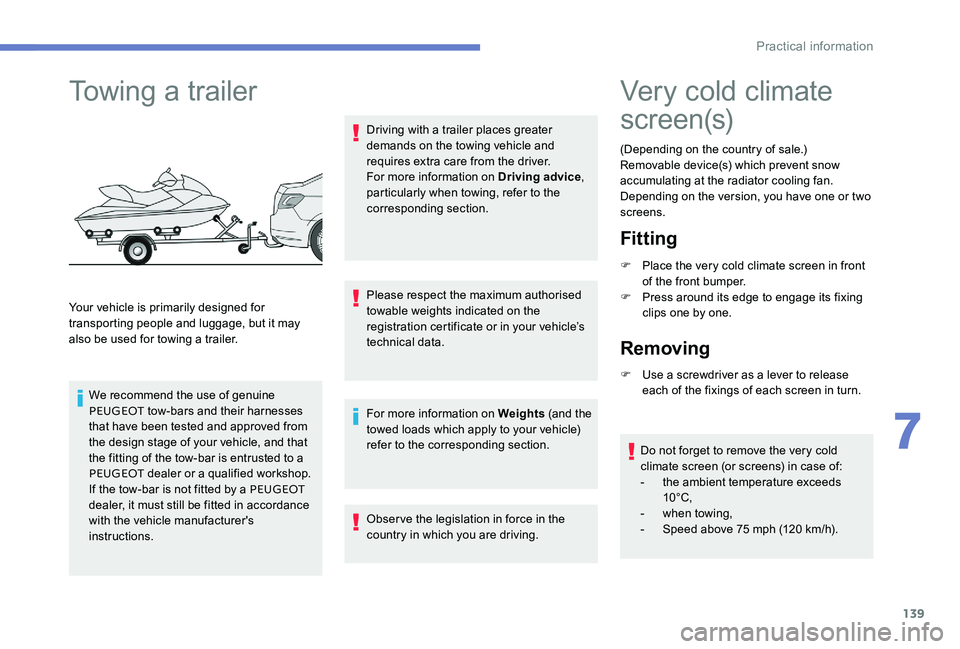
139
Towing a trailer
Your vehicle is primarily designed for
transporting people and luggage, but it may
also be used for towing a trailer.We recommend the use of genuine
PEUGEOT tow-bars and their harnesses
that have been tested and approved from
the design stage of your vehicle, and that
the fitting of the tow-bar is entrusted to a
PEUGEOT dealer or a qualified workshop.
If the tow-bar is not fitted by a PEUGEOT
dealer, it must still be fitted in accordance
with the vehicle manufacturer's
instructions. Driving with a trailer places greater
demands on the towing vehicle and
requires extra care from the driver.
For more information on Driving advice
,
particularly when towing, refer to the
corresponding section.
Please respect the maximum authorised
towable weights indicated on the
registration certificate or in your vehicle’s
technical data.
Very cold climate
screen(s)
(Depending on the country of sale.)
Removable device(s) which prevent snow
accumulating at the radiator cooling fan.
Depending on the version, you have one or two
screens.
Fitting
F Place the very cold climate screen in front of the front bumper.
F
P
ress around its edge to engage its fixing
clips one by one.
Removing
F Use a screwdriver as a lever to release each of the fixings of each screen in turn.
Do not forget to remove the very cold
climate screen (or screens) in case of:
-
t
he ambient temperature exceeds
10°C,
-
w
hen towing,
-
S
peed above 75 mph (120 km/h).
Observe the legislation in force in the
country in which you are driving. For more information on Weights
(and the
towed loads which apply to your vehicle)
refer to the corresponding section.
7
Practical information
Page 142 of 306
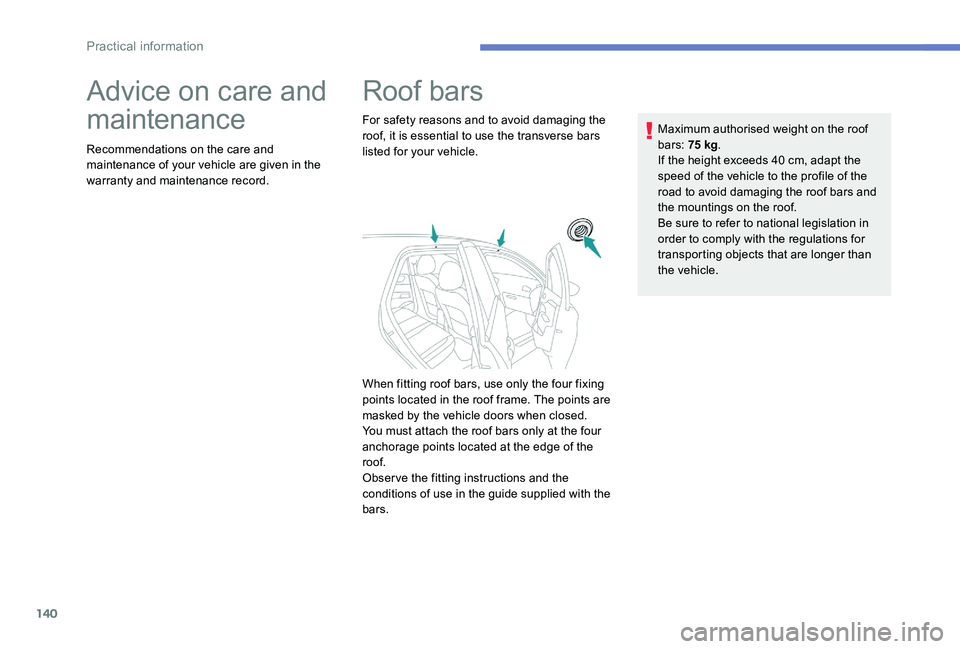
140
Advice on care and
maintenance
Recommendations on the care and
maintenance of your vehicle are given in the
warranty and maintenance record.
Roof bars
For safety reasons and to avoid damaging the
roof, it is essential to use the transverse bars
listed for your vehicle.
When fitting roof bars, use only the four fixing
points located in the roof frame. The points are
masked by the vehicle doors when closed.
You must attach the roof bars only at the four
anchorage points located at the edge of the
roof.
Observe the fitting instructions and the
conditions of use in the guide supplied with the
bars.Maximum authorised weight on the roof
bars: 75 kg
.
If the height exceeds 40 cm, adapt the
speed of the vehicle to the profile of the
road to avoid damaging the roof bars and
the mountings on the roof.
Be sure to refer to national legislation in
order to comply with the regulations for
transporting objects that are longer than
the vehicle.
Practical information
Page 143 of 306
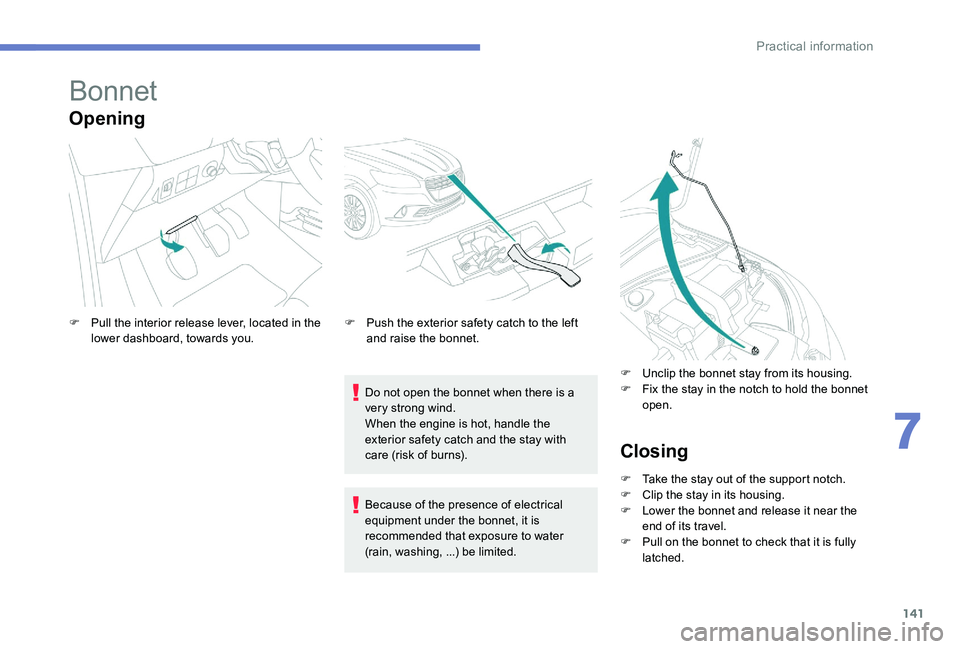
141
Bonnet
Opening
Do not open the bonnet when there is a
very strong wind.
When the engine is hot, handle the
exterior safety catch and the stay with
care (risk of burns).
F
P
ull the interior release lever, located in the
lower dashboard, towards you. F
P
ush the exterior safety catch to the left
and raise the bonnet.
F
U
nclip the bonnet stay from its housing.
F F ix the stay in the notch to hold the bonnet
open.
Closing
F Take the stay out of the support notch.
F C lip the stay in its housing.
F
L
ower the bonnet and release it near the
end of its travel.
F
P
ull on the bonnet to check that it is fully
latched.
Because of the presence of electrical
equipment under the bonnet, it is
recommended that exposure to water
(rain, washing, ...) be limited.
7
Practical information
Page 144 of 306
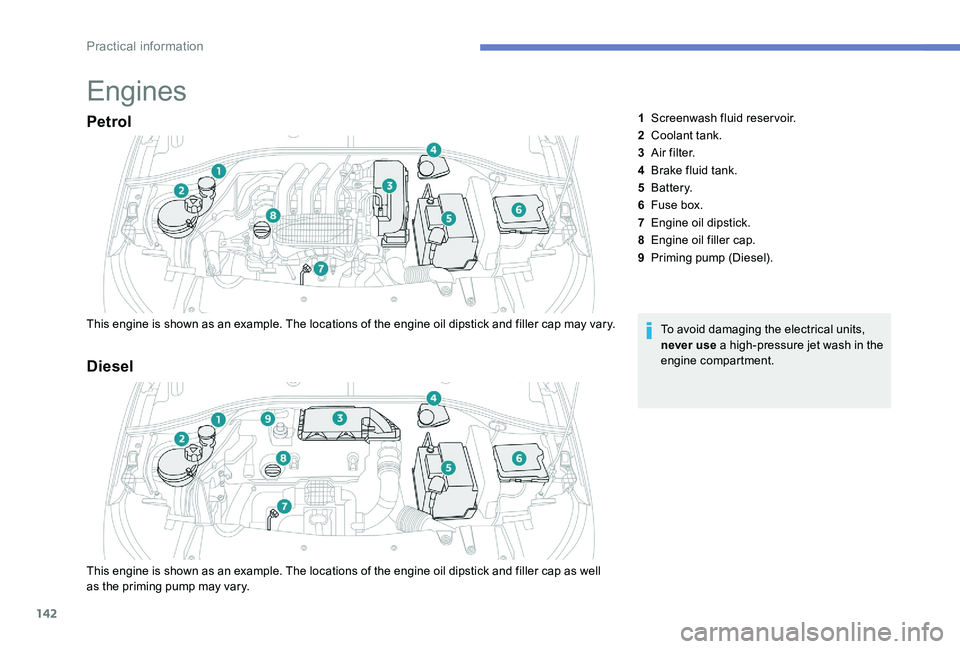
142
Engines
Petrol
This engine is shown as an example. The locations of the engine oil dipstick and filler cap may vary.To avoid damaging the electrical units,
never use a high-pressure jet wash in the
engine compartment.
Diesel
This engine is shown as an example. The locations of the engine oil dipstick and filler cap as well
as the priming pump may vary.1
Screenwash fluid reservoir.
2 Coolant tank.
3 A i r f i l t e r.
4 Brake fluid tank.
5 Battery.
6 Fuse box.
7 Engine oil dipstick.
8 Engine oil filler cap.
9 Priming pump (Diesel).
Practical information
Page 145 of 306
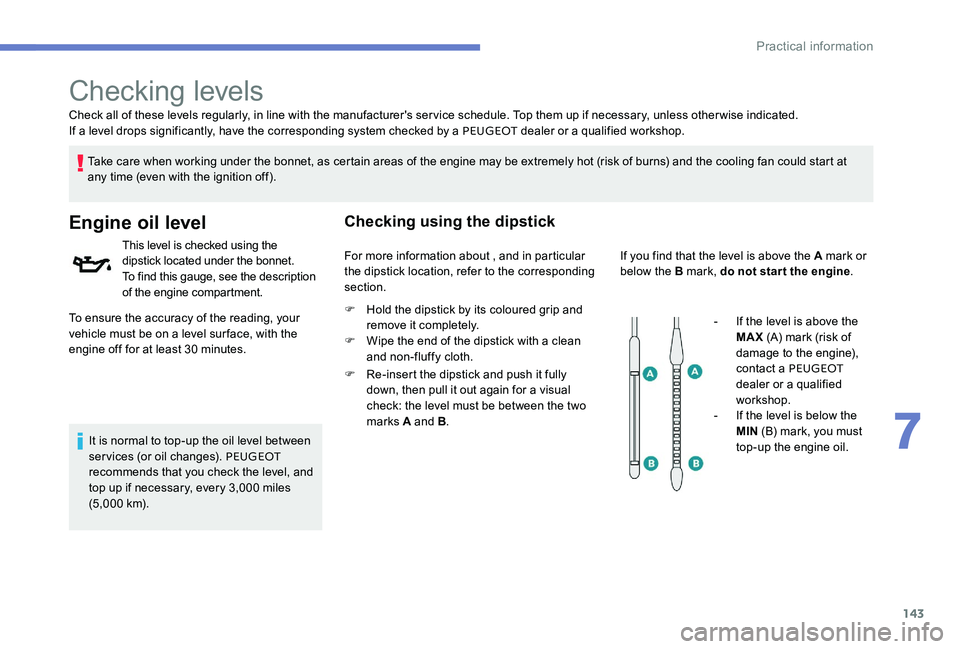
143
Check all of these levels regularly, in line with the manufacturer's service schedule. Top them up if necessary, unless other wise indicated.
If a level drops significantly, have the corresponding system checked by a PEUGEOT dealer or a qualified workshop.
Take care when working under the bonnet, as certain areas of the engine may be extremely hot (risk of burns) and the cooling fan could start at
any time (even with the ignition off).
Checking levels
Engine oil level
To ensure the accuracy of the reading, your
vehicle must be on a level sur face, with the
engine off for at least 30 minutes.
It is normal to top-up the oil level between
services (or oil changes). PEUGEOT
recommends that you check the level, and
top up if necessary, every 3,000 miles
(5,000 km). This level is checked using the
dipstick located under the bonnet.
To find this gauge, see the description
of the engine compartment.
Checking using the dipstick
For more information about , and in particular
the dipstick location, refer to the corresponding
section.
F
H
old the dipstick by its coloured grip and
remove it completely.
F
W
ipe the end of the dipstick with a clean
and non-fluffy cloth.
F
R
e-insert the dipstick and push it fully
down, then pull it out again for a visual
check: the level must be between the two
marks A and B . If you find that the level is above the A mark or
below the B mark, do not star t the engine
.
-
I
f the level is above the
MA X (A) mark (risk of
damage to the engine),
contact a PEUGEOT
dealer or a qualified
workshop.
-
I
f the level is below the
MIN (B) mark, you must
top-up the engine oil.
7
Practical information
Page 146 of 306
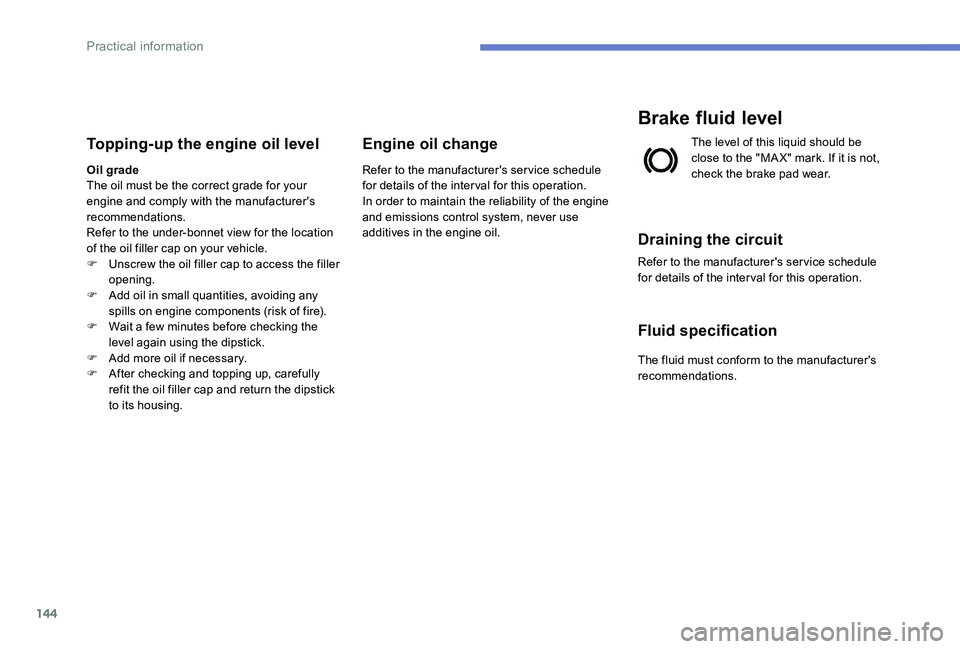
144
Topping-up the engine oil level
Oil grade
The oil must be the correct grade for your
engine and comply with the manufacturer's
recommendations.
Refer to the under-bonnet view for the location
of the oil filler cap on your vehicle.
F
U
nscrew the oil filler cap to access the filler
opening.
F
A
dd oil in small quantities, avoiding any
spills on engine components (risk of fire).
F
W
ait a few minutes before checking the
level again using the dipstick.
F
A
dd more oil if necessary.
F
A
fter checking and topping up, carefully
refit the oil filler cap and return the dipstick
to its housing.
Engine oil change
Refer to the manufacturer's service schedule
for details of the interval for this operation.
In order to maintain the reliability of the engine
and emissions control system, never use
additives in the engine oil.
Brake fluid level
The level of this liquid should be
close to the "MA X" mark. If it is not,
check the brake pad wear.
Draining the circuit
Refer to the manufacturer's service schedule
for details of the interval for this operation.
Fluid specification
The fluid must conform to the manufacturer's
recommendations.
Practical information
Page 147 of 306
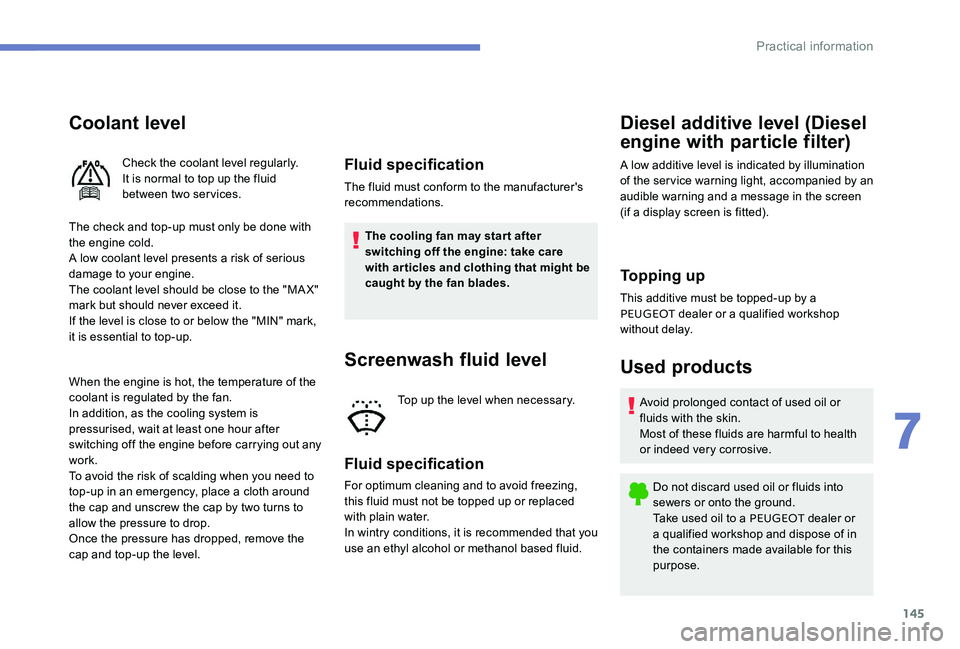
145
Coolant level
The check and top-up must only be done with
the engine cold.
A low coolant level presents a risk of serious
damage to your engine.
The coolant level should be close to the "MA X"
mark but should never exceed it.
If the level is close to or below the "MIN" mark,
it is essential to top-up.
When the engine is hot, the temperature of the
coolant is regulated by the fan.
In addition, as the cooling system is
pressurised, wait at least one hour after
switching off the engine before carrying out any
work.
To avoid the risk of scalding when you need to
top-up in an emergency, place a cloth around
the cap and unscrew the cap by two turns to
allow the pressure to drop.
Once the pressure has dropped, remove the
cap and top-up the level.Check the coolant level regularly.
It is normal to top up the fluid
between two services.
Fluid specification
The fluid must conform to the manufacturer's
recommendations.
The cooling fan may star t after
switching off the engine: take care
with articles and clothing that might be
caught by the fan blades.
Screenwash fluid level
Top up the level when necessary.
Fluid specification
For optimum cleaning and to avoid freezing,
this fluid must not be topped up or replaced
with plain water.
In wintry conditions, it is recommended that you
use an ethyl alcohol or methanol based fluid.
Diesel additive level (Diesel
engine with particle filter)
A low additive level is indicated by illumination
of the service warning light, accompanied by an
audible warning and a message in the screen
(if a display screen is fitted).
To p p i n g u p
This additive must be topped-up by a
PEUGEOT dealer or a qualified workshop
without delay.
Used products
Avoid prolonged contact of used oil or
fluids with the skin.
Most of these fluids are harmful to health
or indeed very corrosive.
Do not discard used oil or fluids into
sewers or onto the ground.
Take used oil to a PEUGEOT dealer or
a qualified workshop and dispose of in
the containers made available for this
purpose.
7
Practical information
Page 148 of 306
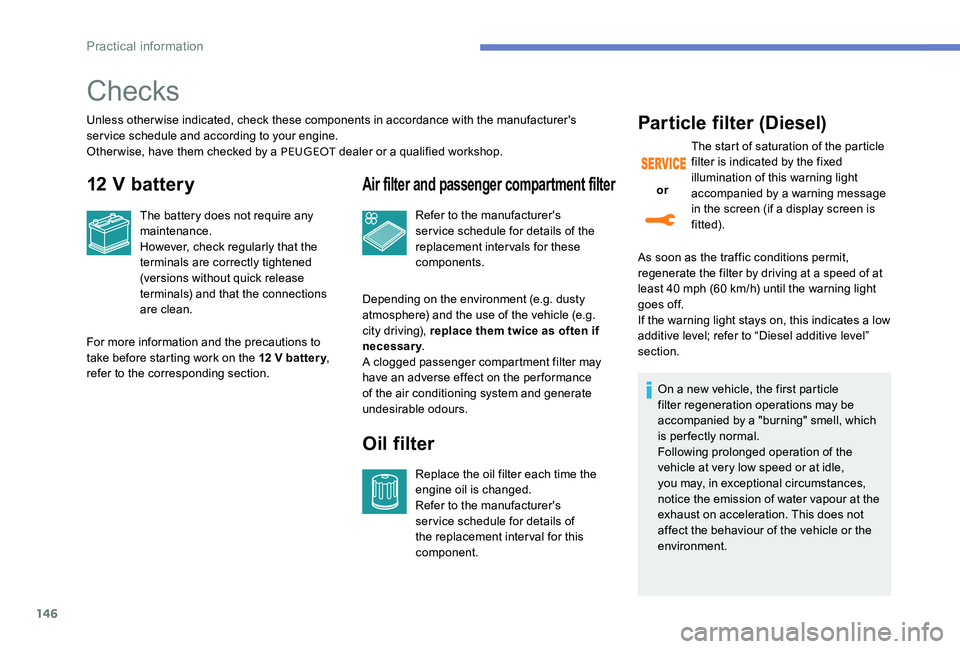
146
Checks
Unless otherwise indicated, check these components in accordance with the manufacturer's
service schedule and according to your engine.
Other wise, have them checked by a PEUGEOT dealer or a qualified workshop.
12 V battery
For more information and the precautions to
take before starting work on the 12 V batter y,
refer to the corresponding section. The battery does not require any
maintenance.
However, check regularly that the
terminals are correctly tightened
(versions without quick release
terminals) and that the connections
are clean.
Air filter and passenger compartment filter
Depending on the environment (e.g. dusty
atmosphere) and the use of the vehicle (e.g.
city driving), replace them twice as often if
necessary
.
A clogged passenger compartment filter may
have an adverse effect on the per formance
of the air conditioning system and generate
undesirable odours. Refer to the manufacturer's
service schedule for details of the
replacement intervals for these
components.
Oil filter
Replace the oil filter each time the
engine oil is changed.
Refer to the manufacturer's
service schedule for details of
the replacement interval for this
component.
Particle filter (Diesel)
As soon as the traffic conditions permit,
regenerate the filter by driving at a speed of at
least 40 mph (60 km/h) until the warning light
goes off.
If the warning light stays on, this indicates a low
additive level; refer to “Diesel additive level”
section.
or
The start of saturation of the particle
filter is indicated by the fixed
illumination of this warning light
accompanied by a warning message
in the screen (if a display screen is
fitted).
On a new vehicle, the first particle
filter regeneration operations may be
accompanied by a "burning" smell, which
is per fectly normal.
Following prolonged operation of the
vehicle at very low speed or at idle,
you may, in exceptional circumstances,
notice the emission of water vapour at the
exhaust on acceleration. This does not
affect the behaviour of the vehicle or the
environment.
Practical information
Page 149 of 306
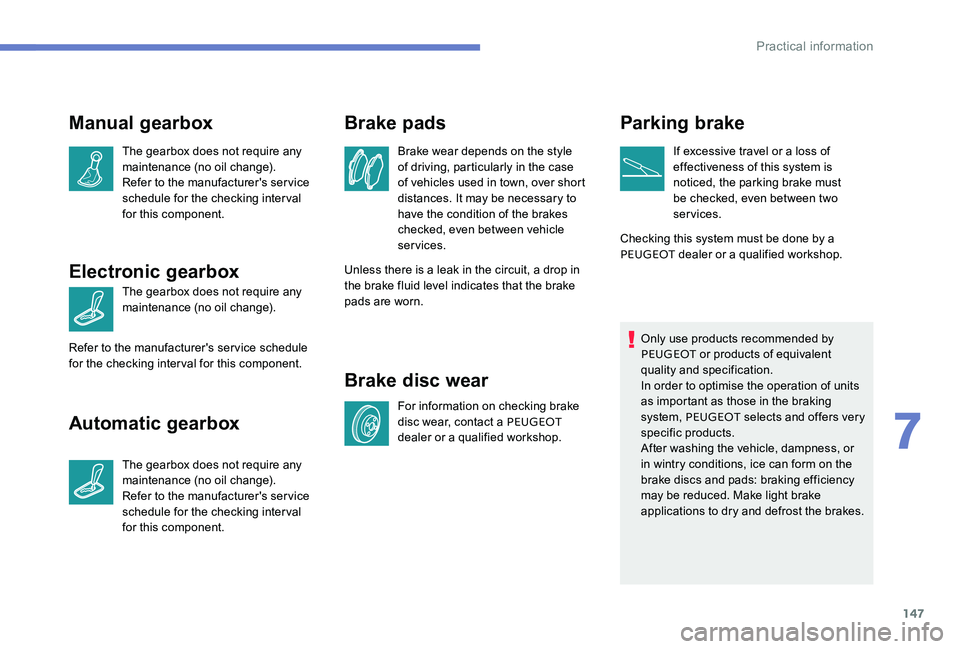
147
Manual gearbox
The gearbox does not require any
maintenance (no oil change).
Refer to the manufacturer's service
schedule for the checking interval
for this component.
Electronic gearbox
The gearbox does not require any
maintenance (no oil change).
Refer to the manufacturer's service schedule
for the checking interval for this component.
Automatic gearbox
The gearbox does not require any
maintenance (no oil change).
Refer to the manufacturer's service
schedule for the checking interval
for this component.
Brake pads
Brake wear depends on the style
of driving, particularly in the case
of vehicles used in town, over short
distances. It may be necessary to
have the condition of the brakes
checked, even between vehicle
services.
Unless there is a leak in the circuit, a drop in
the brake fluid level indicates that the brake
pads are worn.
Brake disc wear
For information on checking brake
disc wear, contact a PEUGEOT
dealer or a qualified workshop.
Parking brake
If excessive travel or a loss of
effectiveness of this system is
noticed, the parking brake must
be checked, even between two
services.
Checking this system must be done by a
PEUGEOT dealer or a qualified workshop.
Only use products recommended by
PEUGEOT or products of equivalent
quality and specification.
In order to optimise the operation of units
as important as those in the braking
system, PEUGEOT selects and offers very
specific products.
After washing the vehicle, dampness, or
in wintry conditions, ice can form on the
brake discs and pads: braking efficiency
may be reduced. Make light brake
applications to dry and defrost the brakes.
7
Practical information
Page 150 of 306
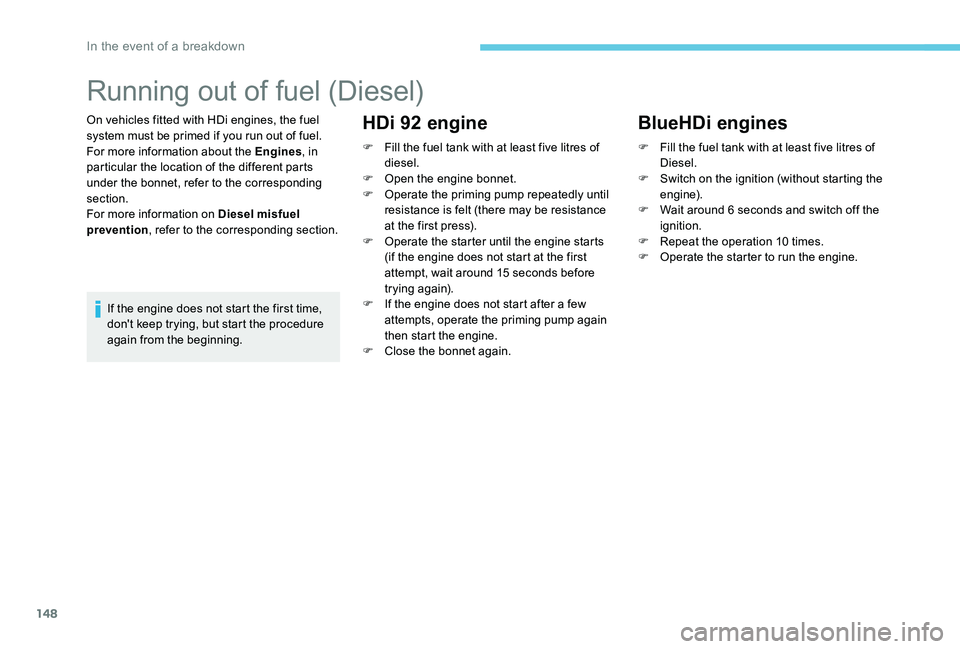
148
Running out of fuel (Diesel)
On vehicles fitted with HDi engines, the fuel
system must be primed if you run out of fuel.
For more information about the Engines, in
particular the location of the different parts
under the bonnet, refer to the corresponding
section.
For more information on Diesel misfuel
prevention , refer to the corresponding section.
If the engine does not start the first time,
don't keep trying, but start the procedure
again from the beginning.HDi 92 engine
F Fill the fuel tank with at least five litres of diesel.
F
O
pen the engine bonnet.
F
O
perate the priming pump repeatedly until
resistance is felt (there may be resistance
at the first press).
F
O
perate the starter until the engine starts
(if the engine does not start at the first
attempt, wait around 15 seconds before
trying again).
F
I
f the engine does not start after a few
attempts, operate the priming pump again
then start the engine.
F
C
lose the bonnet again.
BlueHDi engines
F Fill the fuel tank with at least five litres of Diesel.
F
S
witch on the ignition (without starting the
engine).
F
W
ait around 6 seconds and switch off the
ignition.
F
R
epeat the operation 10 times.
F
O
perate the starter to run the engine.
In the event of a breakdown